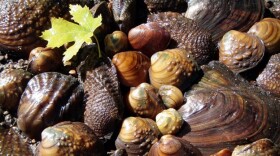Do you like snakes? Not everyone does. Some friends who live on a Vilas County lake believe they are seeing far more watersnakes up around here these days. And they reported that their fellow lake residents - otherwise normal, intelligent people - believe the DNR planted snakes to deal with some invasive frogs.
I decided to find out more about watersnakes, and knowing nothing, I started looking for resources. I was tipped off to a spectacular new book, The Amphibians and Reptiles of Wisconsin by Joshua Kapfer and Donald Brown. It is a tome of over a thousand pages, but beautifully written and organized with plenty of photos, and reasonably priced.
The Common Watersnake, Nerodia sipedon, is common throughout much of eastern North America. Our local subspecies, the Northern Watersnake, is common throughout much of Wisconsin. It is most important to know that the Common Watersnake is non-venomous. They can bite, but they cannot really hurt you. Some people confuse them with Cottonmouths, which are venomous, and Cottonmouths do kinda look like Watersnakes, but we have no Cottonmouths in Wisconsin so relax – you are safe. The Northern Watersnakes have contrasting brown and rust-colored bands on their back, and their belly is quite gorgeous with little reddish half-moons against a tan background. (I am going to have to take the word of the authors on this – I am not going to turn one over to admire its belly spots.)
Northern Watersnakes can also be confused with Eastern Milksnakes, Eastern Foxsnakes and Massasaugas, and they all have blotchy spots or bands like the Watersnake. Of these, only the Massasauga, a rattlesnake, is venomous. However, its range does not extend up to our area and it is very rare, so again - you are safe. Foxsnakes and Milksnakes, neither of which are venomous, may overlap geographically with Northern Watersnakes, but their habitat preferences do not really align. If you see a snake in the water, it is highly likely that it is a harmless Northern Watersnake.
The Northern Watersnake eats mostly fish and frogs and other amphibians, and can stay underwater for up to two minutes, often cruising near the bottom, poking into crevices, looking for small fish. These snakes, in turn, may be prey to racoons, weasels, Bald Eagles, snapping turtles and Great Blue Herons. However, Northern Watersnakes can get big – up to three feet and weigh as much as a pound. Females are generally larger than males and either sex would likely be quite a handful or talon-ful for a predator. When swimming, you can usually just see their heads out of the water. For comparison, a cottonmouth (did I mention you will never see them up here?) swims with its whole body at the water’s surface. Northern Watersnakes spend lots of time basking, especially on dead trees over the water, or on rocks or logs along the shore. They usually stick pretty close to the water’s edge, not usually venturing far upland or even very far out into the water. They bear live young, usually in late August or September and more than one dad may have parented the litter.
So, are there more snakes now than in the past? DNR fish biologist Greg Sass, stationed at Escanaba Research Station, reports he does believe there are more water snakes than in the past, especially in areas where and when tadpoles are abundant. WDNR turtle and wildlife expert Carly Lapin also has had reports from the public (which are usually complaints) about increasing numbers of watersnakes. Why might we be seeing more snakes? I reached out to Josh Kapfer, one of the authors of The Amphibians and Reptiles of Wisconsin I mentioned earlier, and he thinks there might be many reasons. When a plant or animal increases or decreases, you always want to look at the effects of changes in climate, habitat, prey or predators, as well as variability of reproductive success. Maybe it is a warming climate, which might be better for snakes. Maybe with all the fluctuating water levels there is more habitat along lake edges. Maybe the snakes just had a good year or maybe frogs, their main prey, had a good year. It is not clear if their numbers were especially high just this year, or if this is a growing trend. So, no real answers here, except an acknowledgement that they do seem to be more abundant.
Is the DNR really planting water snakes to fight invasive frogs? No. For one thing, there are no invasive frogs in Wisconsin and for another, just plain no. Yes, there might be more snakes around here, but you will need to go elsewhere to fulfil your itch for a conspiracy story.









